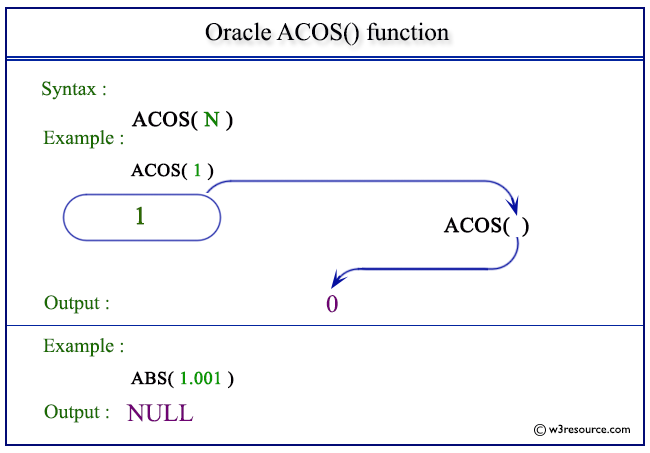Oracle ACOS() function
Description
The ACOS() function is used to calculate the arc cosine (inverse cosine) of a specified number. The function returns a value in the range of 0 to pi, expressed in radians and returns an error message when the value of the number is not in the range -1 to 1.
The function takes any numeric or nonnumeric data type (can be implicitly converted to a numeric data type) as an argument.
If the argument is BINARY_FLOAT, then the function returns BINARY_DOUBLE. Otherwise, the function returns the same numeric data type as the argument.
Uses of Oracle ACOS() Function
- Trigonometric Calculations: Determine the angle corresponding to a given cosine value.
- Mathematical Modeling: Useful in mathematical models and simulations requiring inverse trigonometric functions.
- Engineering Applications: Applied in various engineering fields for angle calculations in radian measure.
- Data Analysis: Assist in data analysis involving trigonometric transformations and calculations.
- Scientific Research: Employed in scientific research for computations involving trigonometric functions and angles.
Syntax:
ACOS(N)
Parameters:
| Name | Description |
|---|---|
| N | A number whose arc cosine value is to be retrieved. |
Pictorial Presentation of ACOS() function

Example
The following statement shows that the statement will return the arc cosine value of the number defined as an argument.
SELECT ACOS(1) FROM dual;
Here is the result.
ACOS(1)
----------
0
Example: ACOS() function using fractional number
The following statement will return arc cosine of the fractional value defined in an argument.
SELECT ACOS(.053211) FROM dual;
Here is the result.
ACOS(.053211) ------------- 1.51756018
Example : ACOS() function using zero(0)
The statement below will return the arc cosine value of the number defined as an argument.
SELECT ACOS(0) FROM dual;
Here is the result.
ACOS(0) ---------- 1.57079633
